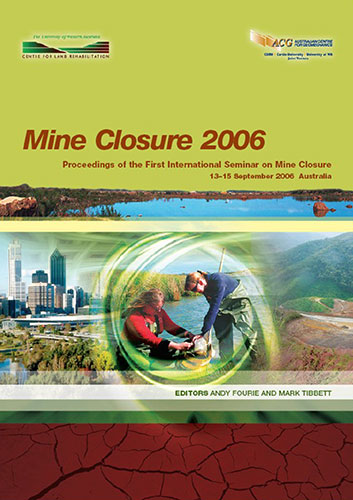The Wismut Remediation Project

|
Authors: Lersow, M; Schmidt, P |
DOI https://doi.org/10.36487/ACG_repo/605_10
Cite As:
Lersow, M & Schmidt, P 2006, 'The Wismut Remediation Project', in AB Fourie & M Tibbett (eds), Mine Closure 2006: Proceedings of the First International Seminar on Mine Closure, Australian Centre for Geomechanics, Perth, pp. 181-190, https://doi.org/10.36487/ACG_repo/605_10
Abstract:
In 1947, the Soviet occupation forces in Germany established the state-run stockholding company (SAG) Wismut. Run by the Soviet military, the company’s sole aim was the exploitation of the East German uranium deposits for the Soviet nuclear programme. During the early “wild” years, uranium mining in Saxony and Thuringia was characterized by poor working conditions, complete disregard for the environmental concerns of the densely populated areas, and a destructive exploitation of natural and human resources. Founded in 1954, the new bi-national Soviet-German company (SDAG) Wismut continued uranium mining with a workforce of up to 120000 employees. However, in the wake of the German reunification in 1990, more than 40 years of intensive uranium mining and milling came to an end. During that period, the Wismut company had produced a total of 231000 tonnes of uranium. In global terms, this ranks WISMUT in post-war uranium production as number three, after the United States and Canada as first and second, respectively. In 1991, the Soviet Union relinquished its shares under the terms of a state treaty. The Federal Republic of Germany took over the stock shares to 100% and also assumed the responsibility for the remediation of the devastated area. Under provision of the Wismut Act, the former SDAG Wismut was legally transferred into a company under German corporate law (Wismut GmbH). The sole shareholder became the Federal Republic of Germany, represented by the Federal Ministry of Economics and Technology. Subsequently, the Ministry took measures to restructure the company and to establish a company charged with the decommissioning of mining and milling installations and with remediation of the sites. Various affiliated mine support companies, e.g. mechanical engineering, structural steelwork, consulting, civil engineering, and logistics, were split from WISMUT and successfully privatised. In 1991, the Wismut Remediation Project was launched. The sheer size of the Project is illustrated by the legacies left by the intensive uranium production (see Table 1). It is worth stating that the remediation is similarly time- and work-consuming as the former uranium production itself. Table 1 Uranium production legacies at WISMUT sites Site Aue, Pöhla Königstein Ronneburg Seelingstädt, Crossen Plant area 570 ha 140 ha 1670 ha 1310 ha Mine dumps number 20 3 16 9 area 370 ha 40 ha 600 ha 530 ha volume 47 million m³ 4.5 million m³ 188 million m³ 72 million m³ Tailings ponds number 1 3 3 7 area 3.5 ha 4.6 ha 9 ha 710 ha volume 0.3 million m³ 0.2 million m³ 0.25 million m³ 160 million m³ Open pit mine area 160 ha volume 84 million m³
References:
Lersow, M. (2006) Status and results of the Wismut Environmental Remediation Project; presentation at the Second
Joint Convention Review Meeting; IAEA, Vienna, May 2006.
Hagen, M., Kunze, C. and Schmidt, P. (2005) Decommissioning and rehabilitation of uranium and thorium production
facilities, Kerntechnik, Vol. 70, No. 1-2. Carl Hanser Verlag München, pp. 91-99.
Schmidt, P. (2004) Improvement of the radon situation at former uranium mining and milling sites in East Germany as
Part of the Wismut Rehabilitation Project, Internat. Congress Series Vol. 1276, ISBN 0-444-514132-7 (2005),
pp. 238-240; presented at the International Conference on High Levels of Natural Radioactivity and Radon
Areas, Osaka, Japan, 2004.
Lersow, M. (2001) Deep soil compaction as a method of ground improvement and to stabilization of wastes and slopes
with danger of liquefaction, determining the modulus of deformation and shear strength parameters of loose
rock. Waste Management 21(2): pp. 161-74 New York, Amsterdam, Tokyo, Singapore, Rio de Janeiro, 2001.
The Wismut Remediation Project M. Lersow, P. Schmidt
190 Mine Closure 2006, Perth, Australia
© Copyright 2026, Australian Centre for Geomechanics (ACG), The University of Western Australia. All rights reserved.
View copyright/legal information
Please direct any queries or error reports to repository-acg@uwa.edu.au
View copyright/legal information
Please direct any queries or error reports to repository-acg@uwa.edu.au